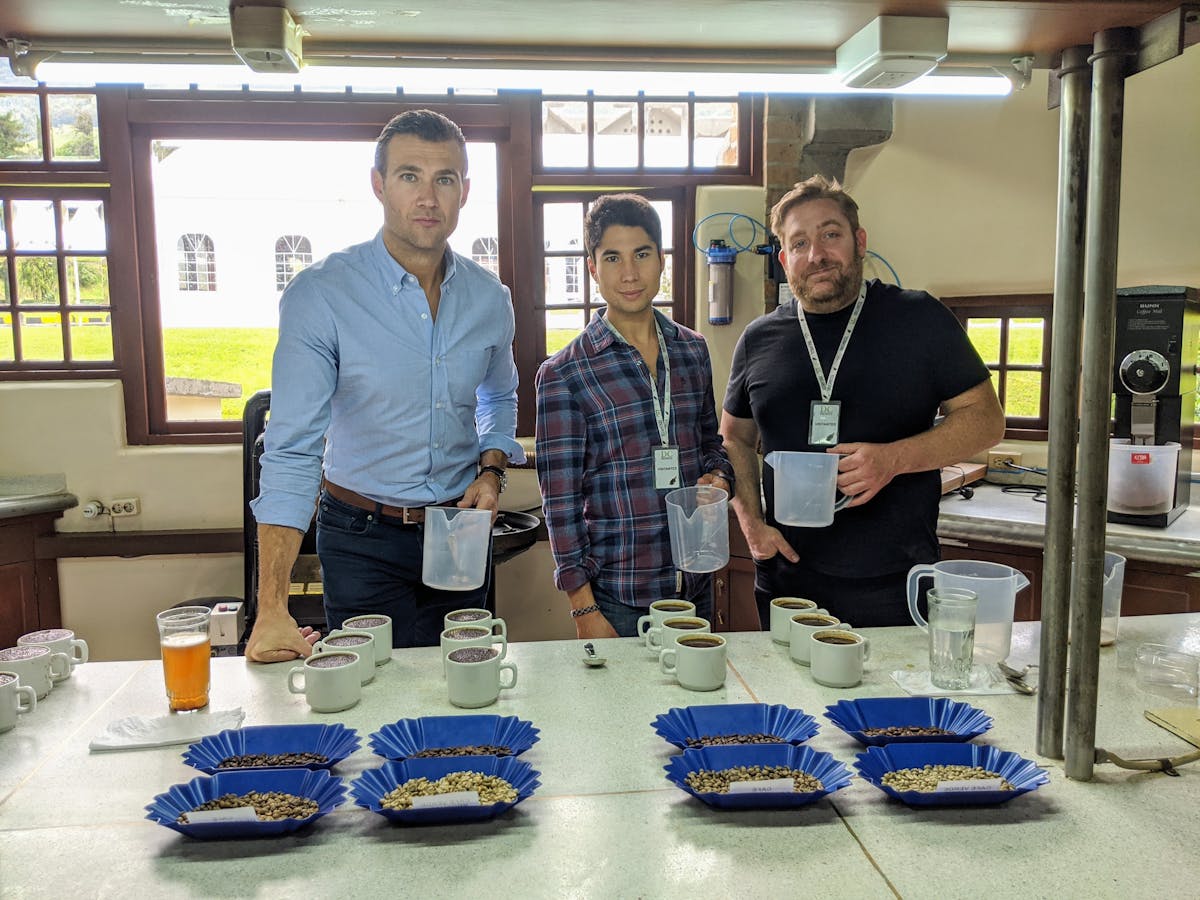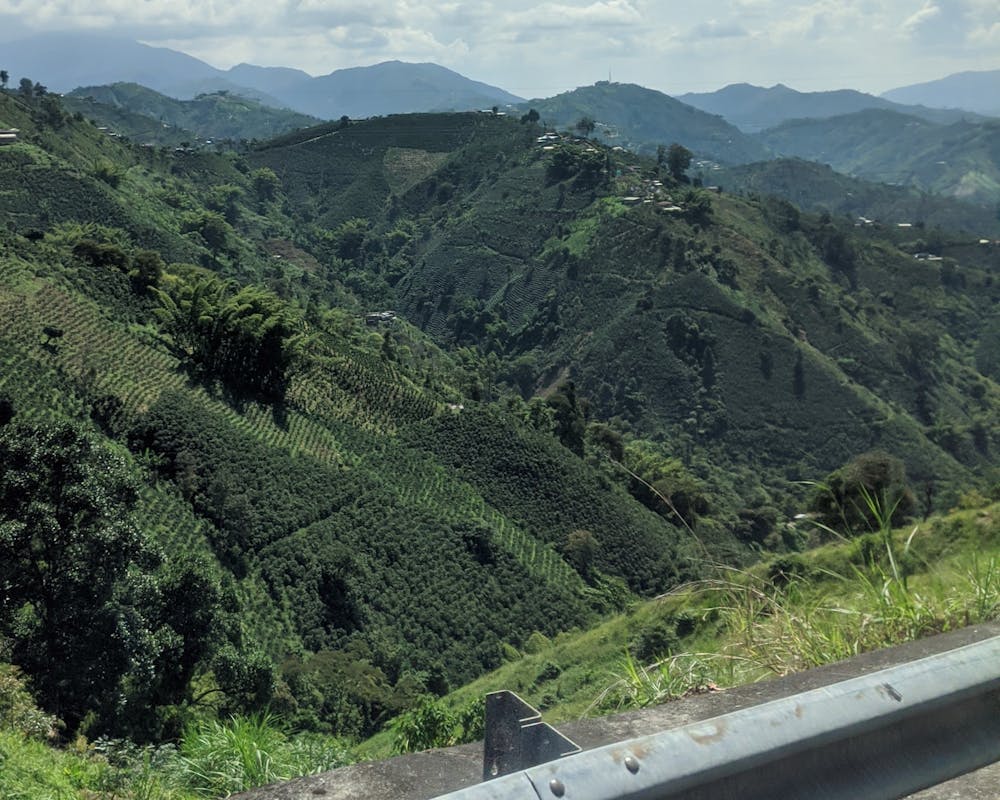From Manizales, Colombia. Our No Strings [Really Good] Decaf Origin Story

By Russ Wilkin, VP of Marketing & Product
Late in 2019 - we wrapped up an amazing classroom project at our Penn State Experiential Learning Cafe, and learned something interesting from our student partners. There were many moments when they wanted to enjoy our cold brew coffee later in the day -- but didn’t always want all the caffeine. At the same time - we heard that decaf coffee is “really bad”. When the word ‘decaf’ would come up - they’d think about ‘tins with green lids’ or ‘something I’d only see my grandparents make’.
So we asked ourselves the question - why is decaf coffee really bad? Does it have to be that way? Can we make it “really good” instead?
During that same month - our VP of Coffee, David Amos was planning one of his many trips to connect with our coffee partners in Colombia, and he wanted to share something with Nick (our Founder & CEO) and me. He knew that the decaffeination process could be harsh - strong chemicals or heat are often applied to the green coffee to extract the caffeine. BUT there was a gentler, more natural way to decaffeinate coffee; sometimes described as a ‘sugar scrub’. He invited us to join him on a trip to see the process up-close so that we could all understand and work together to create a better decaf!
It was a few weeks before Christmas. Nick & I had a weekend free and we were able to book a quick trip to Bogotá (Colombia) to meet up with David to learn all we could about decaf. We spent a day together cruising through Bogotá on scooters - which ironically was the same day thousands of citizens had taken to the streets to protest the national government. There was a lot of excitement surrounding us, and we embraced the emotion & action of the city that day.
The weather had also taken a turn. It was raining in Bogotá, and David knew that the forecast at Manizales - our destination for the next day - would be worse. The Manizales La Nubia Airport is notoriously difficult to fly into. It has a short runway with a steep dropoff into a river valley; even a smidge of bad weather would cancel the flight. So we decided to wake up early the next morning, fly instead to the closest airport, Pereira -- and take a couple-hour van ride up to Manizales.
Altitude in Pereira is about 4,600 feet. Altitude in Manizales is over 7,000 feet. We weren’t quite prepared for it. While at a comfortable 4,600 feet -- we spent the first hour of that car ride chatting & laughing while taking pictures of the mountainous scenery. Then, as we approached the heights of Manizales, that last hour of the ride had us all holding onto our stomachs and asking attempting to ask the driver "¿Ya llegamos?" (“are we there yet?")
 View from the van ride through the mountains to Manizales.
View from the van ride through the mountains to Manizales.
Maybe it was because we couldn’t wait to escape the altitude-stricken car-sickness -- but we were all thrilled to step out of that van to meet our decaffeination experts in Manizales. We spent a few hours touring the facility and learned more than we ever knew about decaf. Even David was impressed with how much he learned that day. Here are some highlights:
Quality In, Quality Out - is the #1 factor when it comes to creating a good decaf. There is a cost to decaffeinating coffee, so to make up the margin most companies use a lower quality green coffee to keep their costs in check. If you start with coffee that isn’t that great, then you’ll end with coffee that isn’t that great. We learned that the most important thing we can do is to use a ‘really good’ coffee. So, David took a totally different approach when sourcing the coffee we would use for our decaf. He didn't settle on a coffee that was anything less than what he would source for any of our signature blends or single-origin offerings. Instead he set the bar even higher to intentionally find something special, and he honed in on a selection of Castillo & Caturra coffee varieties from the Nariño region of Colombia that he knew would really shine as a decaf.
How you Decaf Matters - if we put a really good coffee into the decaffeination process, the goal is to preserve the flavor & integrity of the coffee and to only extract the caffeine. We use a solution called ethyl acetate - which occurs naturally in fruit such as bananas. That said - it would take a TON of bananas to get the amount of ethyl acetate necessary to decaffeinate tons of coffee, so for these purposes it is isolated from fermented sugar cane. Ethyl acetate is like a magnet for caffeine. So when the coffee is soaked in it, the caffeine dissolves into the solution and the coffee is left behind. This method requires no high heat and very low pressure. As our partners say “they liberate the coffee from the caffeine!” We tasted the ‘full-caf’ (pre-process) & ‘decaf’ versions of a range of low & high grade coffees at the end of the tour. Sure enough - on some we couldn’t tell the difference between the full-caf & decaf versions. But one thing was clear - you need to start with good coffee if you expect to have good decaf.
The caffeine is saved & re-used! The primary destination for our caffeine? It goes into soft drinks. We also tasted a touch of the caffeine before we left...we definitely wouldn’t suggest ever tasting it unless you really, really like the taste of pure bitter.
So after the visit, we took the trip back down to the Pereira airport where we ended up being stranded through a string of flight delays so we had plenty of time to recap what we learned. If we got a ‘really good’ coffee, decaffeinated it with this gentle process, and then served it in our cafes -- we could break the standard that ‘decaf is really bad’ and turn people on to ‘really good decaf’.
Check out our new “Really Good” Decaf Cold Brew. Armed with knowledge we learned that day - David worked with partners in Colombia to find a full-flavored coffee that he knew would work specifically well for decaf. We both source & decaffeinate the coffee in Colombia before we bring it to be profiled at our South Philadelphia roastery - so it is technically a single-origin coffee. The roast profile is specially-tuned to be great for cold brew. Once the coffee is roasted - it is sent to cafes to be served as cold brew, or could be sent straight to your home from our online shop.
 Decaf coffee ready for distribution from Manizales.
Decaf coffee ready for distribution from Manizales.

